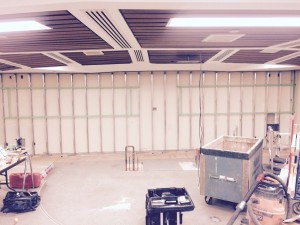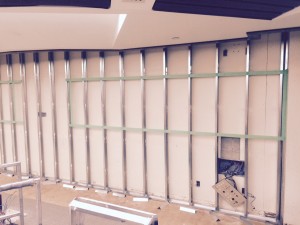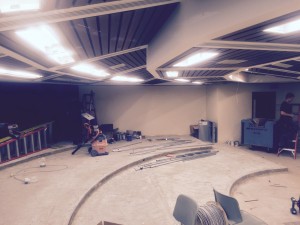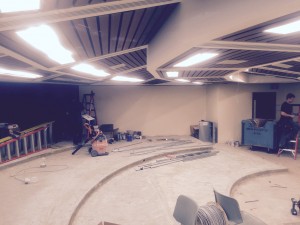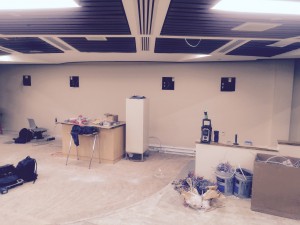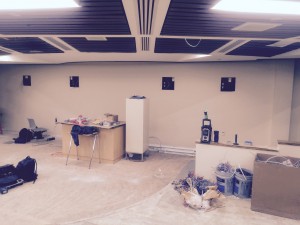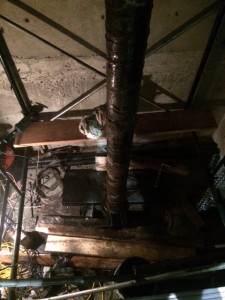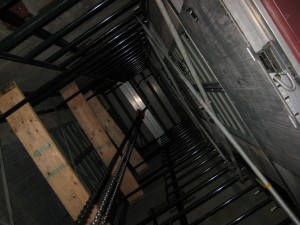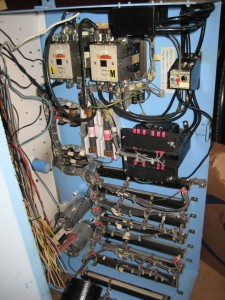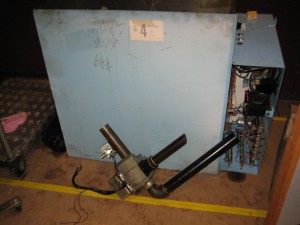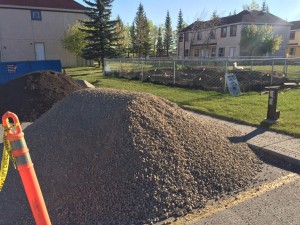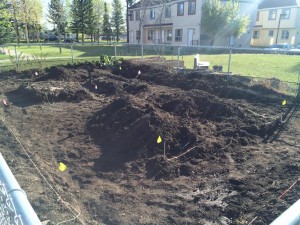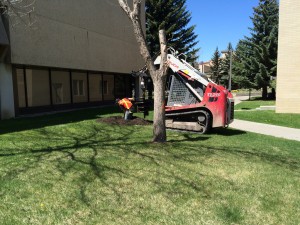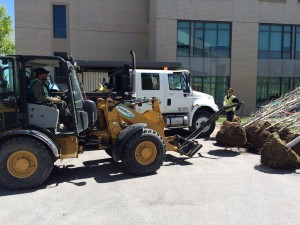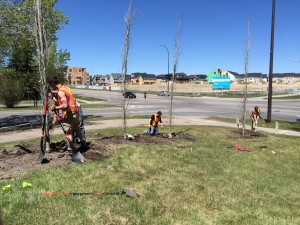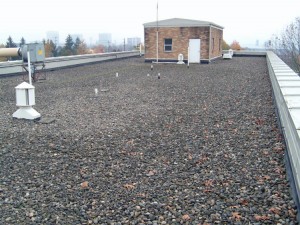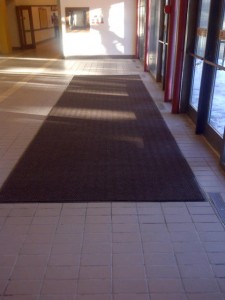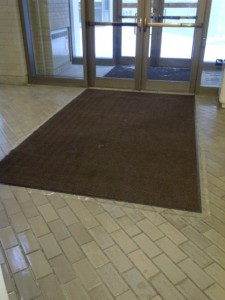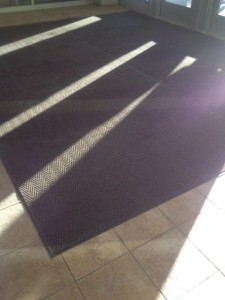B206 – MRU’s First Telepresence Room Is Well On the Way To Completion
Elevator Upgrade Update
To date, the project is moving along well. There are no near miss, injuries or incidents and crews are operating safe. The demolition of mechanical workings within the hoist-ways (shaft the cab travels up and down) has been completed. The power units are now being removed from site. Over the next coming weeks our contractors now begin the long road of installing new elevator specific electrical and mechanical components as well as fire protection device upgrades. All smells or sounds related to the demo will no longer be apparent.
The MRU Community Garden Is Taking Shape
Elevator Modernization
Elevator modernization (or lift modernization) is the process of upgrading the critical parts of the elevator in order for it to be able to handle new technology, have better performance, improve safety, and even give the overall aesthetics an up-to-date appeal
Most elevators are built to provide about 30 to 40 years of service (although some elevators as old as 50 years or more are still in service), as long as service intervals specified and periodic maintenance/inspections by the manufacturer are followed. As the elevator ages and equipment becomes increasingly difficult to find or replace, along with code changes and deteriorating ride performance, a complete overhaul of the elevator is required.
Typically, a modernization will affect the controller equipment (the part of the elevator that controls the movement of the elevator through the floors), the hoist pistons/cylinders and motors/pumps (the part of the elevator that does the heavy lifting), electrical wiring and buttons of the cab (controlling the lights, destination floors, etc.,) even the tracks of the doors are modified and changed, all to keep the elevator up-to-date, and to the aesthetics conscious, paneling, electronics, and additional style changes are also done in the interior of the cabs
For starters, an elevator modernization plan was created. This was done with the help of an Elevator consultant, Service Company, Electrical and Mechanical consultants.
This process determined which parts of the elevator had to be modernized, the scope of the procedure, and most importantly, making sure that code compliance are met (including fire alarm/fire code). Once this was completed, preventive maintenance was done until the elevators were actually removed from service.
During mod time, the elevator is out of service. So, the Department of Physical Resources has planned ahead and worked with the various Departments, Scheduling Services, and various service providers in order to compensate for this outage. Strategic planning includes proper diversion of building’s traffic, creating contingency plans, and so on. This is required due to the scope of modernization, the number of elevators, and the size of the building.
Modernization can greatly improve operational reliability by replacing mechanical relays and contacts with solid-state electronics. Lighting changed to efficient LED technology. Ride quality improved by replacing motor-generator-based drive designs with Variable-Voltage, Variable Frequency (VVVF) drives, providing near-seamless acceleration and deceleration. Passenger safety is also improved by updating systems and equipment (such as double brake system, unintended car movement protection device on the brake system, etc.) to conform to current codes. By modernizing, we will continue with achieving our continuing goals of energy conservation and energy efficiency.
Elevators A, T, and Y are all hydraulic type elevators. The elevator cab is pushed up from below by a large hydraulic piston and cylinder assembly that is now over 30 years old. If the elevator travels a total of 30′ at top, then when the elevator is at the bottom floor, that piston is in the ground 30′. To avoid the potential for any safety issues arising from the age of the equipment, all of the equipment is being replaced.
When the elevators were installed originally, the cylinders and pistons were dropped into the holes by a crane. Now that these are being replaced, they must be lifted out of the hole, cut into pieces and removed for recycling.
Tree Planting Has Started
Tree Planting Scheduled for May 20
MRU lost a lot of trees in the freak September 2014 snowstorm. Later this month we will plan around 40 new trees. It’s a fraction of what we lost but it’s a start.
Roofing Work
This summer a lot of roof repairs will be undertaken and as a result of that work a lot of roofing gravel will be removed. Normally this gravel is taken to the landfill as refuse. Starting this year the Mount Royal University Grounds Department will make use of it onsite and none of it will go to waste or be transported off-site.
New Walk-Off Mats
A big part of keeping an institution clean is keeping dirt, snow, and water from getting too far into the building. That is why there are mats in front of every entrance and exist. MRU has just replaced a number of these mats. It’s made a big difference in improving the cleanliness and the look and feel of the buildings.
Building Codes Where Strict In 1772 BCE
§229-232 – If a builder build a house for a man and do not make its construction firm, and the house which he has built collapse and cause the death of the owner of the house, that builder shall be put to death. If it cause the death of a son of the owner of the house, they shall put to death a son of that builder. If it cause the death of a slave of the owner of the house, he shall give the owner of the house a slave of equal value. If it destroy property, he shall restore whatever it destroyed, and because he did not make the house which he built firm and it collapsed, he shall rebuild the house which collapsed from his own property (i.e., at his own expense). [1]

[1] The Code of Hammurabi, King of Babylon (1904) by Hammurabi, translated by Robert Francis Harper, Original work, c. 1772 BCE; translation published in 1904.
MRU Indoor Temperature Guidelines
Mount Royal University – Indoor Temperature Management Guidelines (November 30, 2014)
OBJECTIVE:
The Mount Royal University Indoor Temperature Management Guideline provides a framework to assist Physical Resources and buildings occupants in jointly achieving a healthy, productive, and safe working environment while reducing energy costs and greenhouse gas emissions to the lowest practicable level.
MANAGEMENT GUIDELINE:
- During the winter heating season, occupied spaces will be heated to 22°C.
- During the summer cooling season, occupied spaces will be cooled to 24.5°C.
PRACTICAL CONSIDERATIONS:
Due to frequent, extreme, and rapid temperature swings in the Calgary area there will be unavoidable transitional periods when indoor temperatures fall outside of these ranges.
This is particularly challenging in the spring and fall ‘swing seasons’ when Physical Resources transitions the building equipment from cooling to heating and vice versa. To complicate matters further, actual temperature may vary due to the wide range of space types, occupancy levels, and access to daylight on campus.
The existence of transition periods is an unfortunate reality in a prairie climate system.
COMMENTS:
These space temperature ranges are based on established standards for human comfort, productivity and safety and are modeled after policies implemented in major universities across North America. The Mount Royal University approach has been modeled after the program in Harvard University in Boston.
Mount Royal will periodically evaluate the Indoor Temperature Management Guideline based on improvements to building systems and feedback from occupants.
We look forward to working with everyone to create a comfortable, energy conserving and sustainable environment. If you have any questions or concerns please contact the Associate Vice President, Physical Resources at 403.440.6419.


